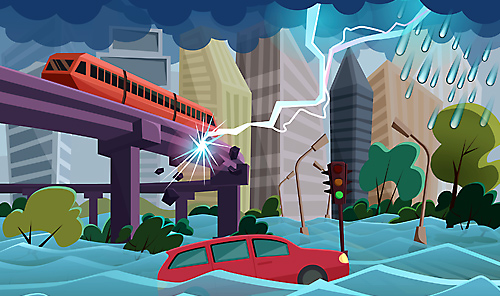In Focus: Rise of Natural Disasters Affecting CRE Markets
With the rise in natural disasters over the past few years and as climate change continues to be a challenge, natural disaster resiliency is top of mind for commercial property executives.
Q1 2019

Hurricanes have proven to be very costly to the real estate industry, particularly to coastline regions, but we have recently seen a shift to inland properties that has created greater cause for concern regarding those assets. With strong winds and heavy rainfall, hurricanes have proven to test the readiness of commercial properties. Damage totals can often be difficult to calculate, and costs to rebuild are not always an accurate reflection, as some assets are not rebuilt immediately or at all.
Construction Improvements
Many cities are working to address the increasing frequency and intensity of natural disasters by directing development to less flood-prone areas and increasing the required elevation to minimize water damage. The construction industry and governments are looking to improve construction materials, design, and building codes, while also calling for more rigid building methods that require roofs, walls, and foundations to be more secure. They are also refining the wind-resistance of structures through improved building materials such as hurricane-resistant concrete blocks and glass windows.
As a related factor, there has been a rise in LEED-certified and Energy Star-rated buildings as the commercial real estate industry is becoming increasingly focused on climate change and designing with sustainability in mind. Almost 40 percent of commercial real estate buildings in the U.S. are LEED-certified.
There currently isn’t an immediate impact on property valuations on coastal properties. However, properties located in locations prone to natural disaster often encounter higher insurance costs to combat the possibilities of an occurrence. This doesn’t have a significant impact on owners as insurance is not a major property expense.
Many real estate owners, operators, and investors are now looking for higher-ground areas that are historically prone to less risk. Owners who do locate in areas that may be at a higher risk for a natural disaster typically design their buildings with this in mind. Some factors they may consider include avoiding known flood plains, larger setbacks from the coastline where possible, and incorporating storm water management into their design.
Project Announcements
Australia-Based Aquatic Leisure Technologies Group Plans Opp, Alabama, Manufacturing Operations
12/11/2025
Teradyne Plans Wixom, Michigan, Robotics Operations
12/11/2025
Robinson Plans Altoona, Iowa, Manufacturing Operations
12/11/2025
BioTouch Expands Columbus, Georgia, Operations
12/11/2025
Natrion Plans Erie County, New York, Battery Components Operations
12/11/2025
Czech-Based GZ PrintPak Expands Mount Pleasant, Wisconsin, Manufacturing Operations
12/11/2025
Most Read
-
The Workforce Bottleneck in America’s Manufacturing Revival
Q4 2025
-
Rethinking Local Governments Through Consolidation and Choice
Q3 2025
-
First Person: Filter King’s Expansion Playbook
Q3 2025
-
Lead with Facts, Land the Deal
Q3 2025
-
How Canada Stays Competitive
Q3 2025
-
Investors Seek Shelter in Food-Focused Real Estate
Q3 2025
-
America’s Aerospace Reboot
Q3 2025